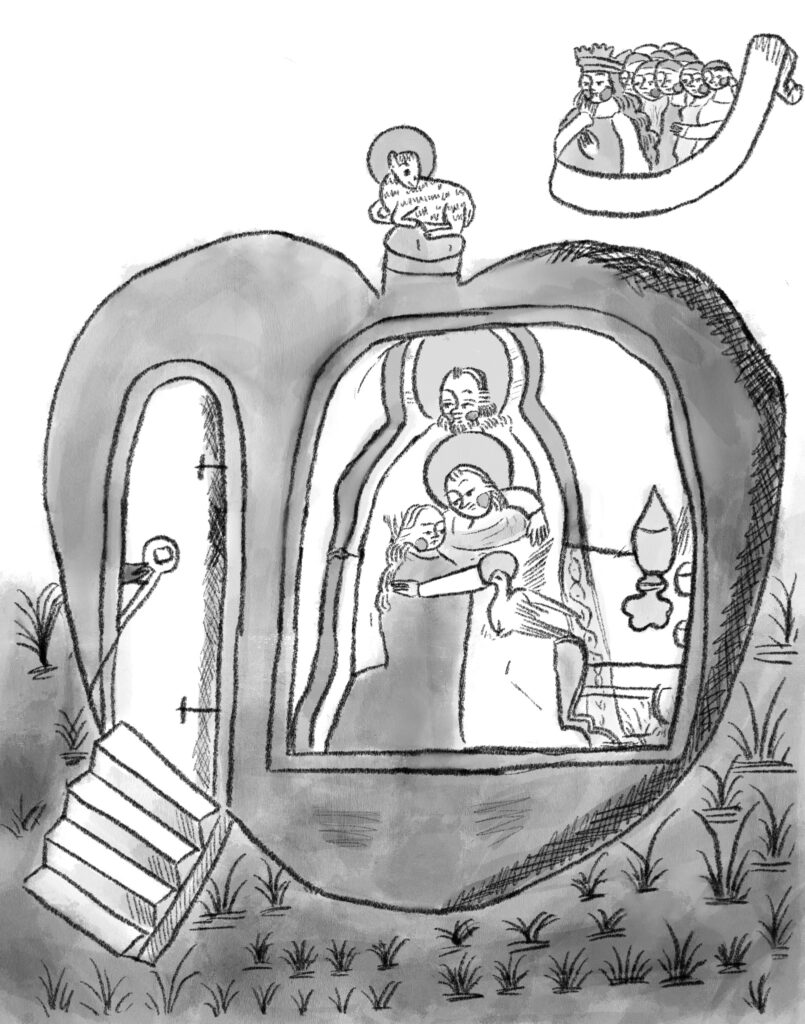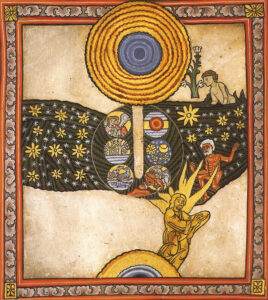hi there!
I’m so glad you’re here with me today to learn about the medieval world — and hopefully, to do a little reflection on yourself as well. Today, we’re doing two things:
- First, we’re going to learn a little about Julian of Norwich, a medieval anchorite.
- Next, we’re going to do a guided meditation based on her words.
Every activity from In Every Sense focuses on one or more specific sensory experiences — this one mostly deals with sound, but we’ll also be holding an object in our hands as we meditate (I’ll explain soon!), which is kinesthetic since we’ll be using our hands and bodies to do so. You can even vary the level of touch involved in this activity — if holding something in your hands doesn’t feel up your alley for this, you can just imagine it.
If that sounds good to you, let’s dive in.
A small and gentle reminder: as always, these activities are more about how you feel and less about whether or not you’re doing it “right.” Together, let’s try to focus more on the act of exploring how we feel, and less on if we’re meditating “correctly.” We’ll get into this a little bit more in just a moment, but first, let’s get started.
part 1: learn a little
Julian of Norwich (1342-c.1423) was a medieval anchorite living in Norwich, England, which is about a hundred miles from London, in eastern England. While she’s become a very influential theologian in Christianity, she also has the distinction of being the author of the first known book written by a woman in the English language. To add to her place literary history, she is also named in Margery Kempe’s autobiography — often considered the first autobiography in English — as someone Margery visited and spoke with during her religious travels. For all her significance, then, we might be surprised to learn that Julian spent much of her life (at least upward of thirty years, but likely more) enclosed in a cell attached to a church, due to her role as an anchorite.
What is an anchorite, then? Anchorites (female anchorites were also called anchoresses) were a certain type of ascetic who wished to retreat from the world so completely that they chose to be sealed into a cell, usually attached to the side of the sanctuary of a church, for the rest of their lives. They would receive something akin to last rites as the door through which they entered the cell was sealed shut, and then would receive Eucharist, food, and supplies through a small window or grille. They would often also speak and consult with people who came to visit them and seek their advice — Julian was certainly one of these anchorites who was often sought out for spiritual guidance, and she even wrote about it in her book. It’s unclear whether or not Julian ever took vows and became a nun, or whether she remained a layperson her whole life (and the scholarly opinion on this differs a lot depending on who you ask). Either way, though, she was clearly dedicated to her religious life in a way that seems almost unfathomable to most of us (or perhaps, in this time where we’ve all experienced our fair share of quarantine, might seem a little more familiar than we’d like!).
Yet Julian was not completely retreated from life and people, as we might think. No, rather, her book, Showings (often also called Revelations of Divine Love) is full to the brim with an appreciation of life and love for others. This may be because it was written as a result of a series of visions she had after a prolonged and serious illness, during which she was certain she would die. This near-death experience was the catalyst for Julian’s writings, and as a result, they are quite interested in life, the body, and how we experience life in our bodies.
Additionally, despite how we might imagine Julian’s life as small, contained, or cramped, she has wide-ranging cosmic visions of the nature of the universe — and that’s what we’ll focus on together today. At one point, she describes being shown the entire universe and her subsequent realization about the fragility and wonder of what she has seen. I think it’s really wonderful, so I’ve included part of it here below. Read through it, and we’ll get ready to meditate on it together.
“And in this he showed me something small, no bigger than a hazelnut, lying in the palm of my hand, as it seemed to me, and it was as round as a ball. I looked at it with the eye of my understanding and thought: what can this be? And it was answered generally thus: it is all that is made. I was amazed that it could last, for I thought that because of its littleness it would suddenly have fallen into nothing. And it was answered in my understanding: it lasts and always will, because God loves it; and thus everything has being through the love of God.” (The Long Text of Showings, chapter V)
part 2: meditate together
What did you think? It’s a lot to take in, right? The whole universe is the size of a hazelnut, and I think Julian voices what comes to my mind right away — that’s kind of nerve-wracking! Don’t worry, we’ll think it through together in just a minute.
As you read, you might have figured out what I meant by us holding something in our hands. We’re going to find something that’s about the size of a hazelnut and hold it in our hands as we mediate. Some suggestions I have, if you don’t have a hazelnut lying around (I certainly don’t, so if you do, good for you!):
- One of those little rubber bouncy balls
- A marble
- A large bead
- A gumball (although that might get sticky in your hand!)
- A crumpled up piece of paper that’s the right size
- A different kind of nut (a pistachio, a walnut, a macadamia, etc.)
- A little ball of string
I used a hair scrunchie that I sort of balled up in my hand to be about the right size. You want something about an inch across, but a little bigger or a little smaller works just fine. And if you can’t find something that works for you, or if you just don’t want to hold something in your hands, that’s great too! Do what works for you.
Once you’ve got your hazelnut or your hazelnut stand-in, sit down somewhere comfortable, get settled, maybe put on some headphones to listen, and press play on the audio and we’ll meditate on it together.
If you have trouble hearing, you think you might not want to listen to something while you meditate, or you just don’t like the sound of my voice, click below and you can see a full transcript of the script.
Thanks for spending time today with me, with Julian, and most of all, with yourself. I’ll see you next time.
P.S. If you want to tell me how you felt about doing this activity, you can drop me a line here.






